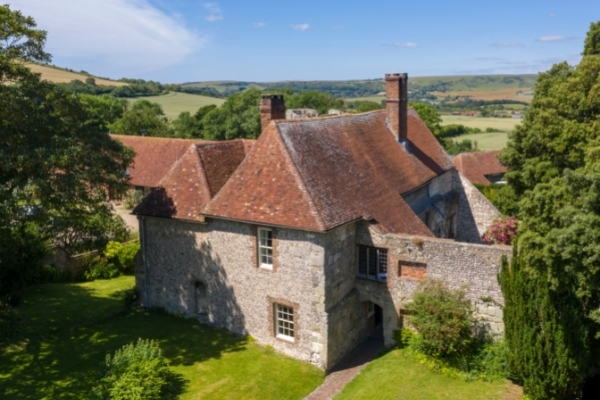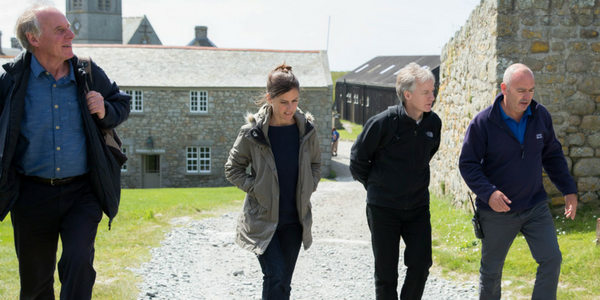This article was originally published in Architectural Historian, the magazine of the Society of Architectural Historians of Great Britain.
Monday
Up and out early to get to Wilmington Priory in Sussex at ten sharp, when the people who have been staying for the week vacate and the Landmark Housekeepers move in. All of Landmark’s 198 buildings are rented out all year round for holidays and short stays; it’s how they are enjoyed and how we fund the charity, so you have to dart in and out during changeovers. Today it’s meeting our ebullient and brilliant housekeeping team and Regional Property Manager, hearing how things are going, and looking at some potential improvements to the building. Landmark converted the derelict priory in the 1970s, occupying the post-monastic house built in the ruins. But keeping it warm is a challenge and there’s never a substitute for talking through the possibilities on site with one of our surveyors. Lunch is sandwiches in the kitchen with the team. On the train back (I always go by train if I possibly can) I work on a speech for a fundraising event later in the week. Back just in time for our 6.30 slot to meet the teacher at the children’s school.
 Wilmington Priory, Sussex
Wilmington Priory, Sussex
Tuesday
Spent at our office at Shottesbrooke Park in Berkshire. Weekly catch-up meeting with the team at 9.30, followed by our fortnightly projects meeting, discussing progress on our two major building rescue projects currently on site, two auto-architectural projects: Mrs Coade’s own house in Lyme Regis, and the presbytery Augustus Pugin built at the Grange in Ramsgate. Lunch round the office kitchen table, with one of our four office dogs eyeing my cheese on toast hungrily. Afternoon run through of next year’s maintenance programme. I walk across the park to have tea with Lady Smith, one of the co-founders of Landmark; though she’s getting pretty hard of hearing she is as hilarious and irreverent as ever. Home in time to give children a bath to usual high volume Elvis soundtrack.
Wednesday
Visiting two buildings at risk – we see around 25 on site a year and are approached about a hundred or so. A derelict church in a sensational spot overlooking Tintern Abbey and a roofless 1730s banqueting house on a ridge gazing down towards the Pembrokeshire coast. Both spellbinding but challenging. Converting churches to domestic use is something we have generally avoided and it’s hard to see how this one would work. The banqueting house is fascinating, it looks like something a local builder dreamt up after seeing Lord Burlington’s Chiswick. All a bit wrong but all the more appealing for it. We stroke our chins about how you’d retain the fragments of plaster and where on earth you could put a bathroom. Back very late.
Thursday
Morning spent discussing what our priorities should be for taking on buildings over the coming decade: should we be targeting medieval piel towers or cold war bunkers? Likely discussion and future paper for our trustees scoped. Call with the Lundy Island manager, Derek Green, to talk through the damage done by recent storms. Agree the format for the launch of ‘Landmark: a History of Britain in 50 buildings’ at Hatchards next month, the book on the Trust that Caroline Stanford and I have written to mark our 50th anniversary. Tea-time reception at Landmark’s 1720s house in Spitalfields for our Legacy pledgers (people who are leaving us money in their wills), who are full of enthusiasm for the projects we have coming up. One elderly guest takes me aside to tell me she loved my speech, leaving me glowing, until she explains that it was because she could hear every word. Dash into the launch of a former English Heritage colleague’s new book just in time for the speeches.
 Anna on Lundy Island with some of Landmark's Trustees
Anna on Lundy Island with some of Landmark's Trustees
Friday
Take the children to school then spend the morning in the London Library mining material for a lecture later in the month. Quick lunch with our Chairman, then over to Channel 4 for a viewing of one of the programmes in the new series they’ve made about our work, ‘Restoring Britain’s Landmarks’. Manage to get back to the library to collect some books just before it closes. Rendez-vous with the children at King’s Cross and squeeze ourselves onto the 5.45 train to King’s Lynn.
Saturday & Sunday
Picnic on Holme next the Sea beach in soft September sun, tea and ice cream at Castle Rising, friends for supper. On Sunday morning I spend a couple of hours on the proofs to ‘The Last Royal Rebel’, my biography of James, Duke of Monmouth, which is finally coming out in the new year. Afternoon spent baking exotic cakes with the children who make free with the food colouring. Ely Cathedral is framed against the setting sun as we drive back to London. The strange smell of black banana cakes fills the car, but the children, now fast asleep, are oblivious.
Thanks to the Society of Architectural Historians of Great Britain for allowing us to share this article. To become a member of the society please visit http://www.sahgb.org.uk/